Computer Aided Process Planning in Aircraft Manufacturing
- 格式:pdf
- 大小:4.55 MB
- 文档页数:10
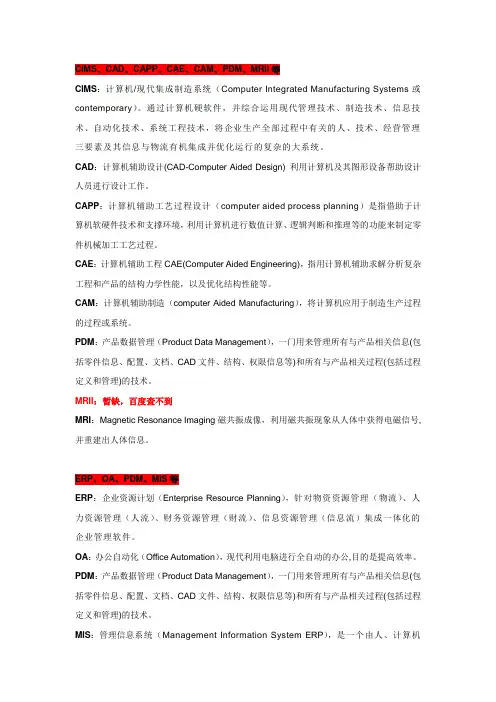
CIMS、CAD、CAPP、CAE、CAM、PDM、MRII等CIMS:计算机/现代集成制造系统(Computer Integrated Manufacturing Systems或contemporary)。
通过计算机硬软件,并综合运用现代管理技术、制造技术、信息技术、自动化技术、系统工程技术,将企业生产全部过程中有关的人、技术、经营管理三要素及其信息与物流有机集成并优化运行的复杂的大系统。
CAD:计算机辅助设计(CAD-Computer Aided Design) 利用计算机及其图形设备帮助设计人员进行设计工作。
CAPP:计算机辅助工艺过程设计(computer aided process planning)是指借助于计算机软硬件技术和支撑环境,利用计算机进行数值计算、逻辑判断和推理等的功能来制定零件机械加工工艺过程。
CAE:计算机辅助工程CAE(Computer Aided Engineering),指用计算机辅助求解分析复杂工程和产品的结构力学性能,以及优化结构性能等。
CAM:计算机辅助制造(computer Aided Manufacturing),将计算机应用于制造生产过程的过程或系统。
PDM:产品数据管理(Product Data Management),一门用来管理所有与产品相关信息(包括零件信息、配置、文档、CAD文件、结构、权限信息等)和所有与产品相关过程(包括过程定义和管理)的技术。
MRII:暂缺,百度查不到MRI:Magnetic Resonance Imaging磁共振成像,利用磁共振现象从人体中获得电磁信号,并重建出人体信息。
ERP、OA、PDM、MIS等ERP:企业资源计划(Enterprise Resource Planning),针对物资资源管理(物流)、人力资源管理(人流)、财务资源管理(财流)、信息资源管理(信息流)集成一体化的企业管理软件。
OA:办公自动化(Office Automation),现代利用电脑进行全自动的办公,目的是提高效率。

高职CAPP课程教学模式研究一、CAPP教学模式概述CAPP(Computer Aided Process Planning,计算机辅助工艺规划)是一种利用计算机技术对产品进行几何造型、材料及工艺选择、工艺规划和工艺文件自动生成的系统。
CAPP 在工程设计、生产制造领域中被广泛应用,它通过优化设计、规范生产过程、提高生产效率和产品质量,实现了工程设计和制造的高度一体化。
在高职教育中,CAPP教学模式主要是指利用CAPP系统辅助教学,将工业技术和实际生产中的过程规划纳入教学内容,使学生在学习过程中即可熟悉工业实践,又可掌握CAPP 系统的基本操作和应用技能,从而提高学生的实际应用能力和就业竞争力。
二、高职CAPP课程教学模式的特点和优势1.实际操作性强:CAPP系统是一个集成了工程设计、生产规划等多种功能于一体的系统,学生可以通过CAPP系统对真实的工业产品进行相关工艺规划和文件生成,真实地锻炼和提高自己的技能。
2.教学与实践相结合:CAPP教学模式将课堂教学与实践操作有机结合在一起,通过理论与实践相结合的教学方式,使学生能够更好地理解和掌握所学知识,提高实际操作能力。
3.培养学生创新意识:CAPP系统的使用需要对产品进行合理的工艺规划,这对学生的创新意识和动手能力提出了很高的要求,有利于激发学生的创新潜能和实践能力。
4.适应产业需求:随着我国制造业转型升级,对高素质技术人才的需求日益增加,采用CAPP教学模式能够更好地培养适应产业需求的技术人才。
三、存在的问题及对策1.教师专业素质不足:由于CAPP系统是一种新型的教学模式,部分高职教师对CAPP 系统的使用和操作并不熟练,教学素质和实践经验相对薄弱,这就给教学工作带来了一定的阻碍。
针对这一问题,高职院校应该加强对教师的培训和引导,提高教师的专业水平和教学能力。
2.设备设施不完善:CAPP系统是一个庞大的工程软件系统,需要先进的计算机设备和相关的辅助设备,以保障学生的学习和操作。
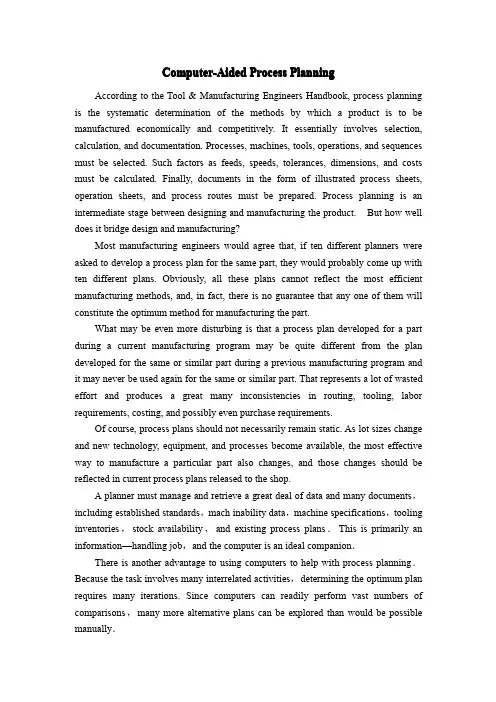
Computer-Aided Process PlanningAccording to the Tool&Manufacturing Engineers Handbook,process planning is the systematic determination of the methods by which a product is to be manufactured economically and competitively.It essentially involves selection, calculation,and documentation.Processes,machines,tools,operations,and sequences must be selected.Such factors as feeds,speeds,tolerances,dimensions,and costs must be calculated.Finally,documents in the form of illustrated process sheets, operation sheets,and process routes must be prepared.Process planning is an intermediate stage between designing and manufacturing the product.But how well does it bridge design and manufacturing?Most manufacturing engineers would agree that,if ten different planners were asked to develop a process plan for the same part,they would probably come up with ten different plans.Obviously,all these plans cannot reflect the most efficient manufacturing methods,and,in fact,there is no guarantee that any one of them will constitute the optimum method for manufacturing the part.What may be even more disturbing is that a process plan developed for a part during a current manufacturing program may be quite different from the plan developed for the same or similar part during a previous manufacturing program and it may never be used again for the same or similar part.That represents a lot of wasted effort and produces a great many inconsistencies in routing,tooling,labor requirements,costing,and possibly even purchase requirements.Of course,process plans should not necessarily remain static.As lot sizes change and new technology,equipment,and processes become available,the most effective way to manufacture a particular part also changes,and those changes should be reflected in current process plans released to the shop.A planner must manage and retrieve a great deal of data and many documents,including established standards,mach inability data,machine specifications,tooling inventories,stock availability,and existing process plans.This is primarily an information—handling job,and the computer is an ideal companion.There is another advantage to using computers to help with process planning.Because the task involves many interrelated activities,determining the optimum plan requires many iterations.Since computers can readily perform vast numbers of comparisons,many more alternative plans can be explored than would be possible manually.A third advantage in the use of computer-aided process planning is uniformity. Several specific benefits Can be expected from the adoption of computer-aided process—planning techniques:1.Reduced clerical effort in preparation of instructions.2.Fewer calculation errors due to human error.3.Fewer oversights in logic or instructions because of the promptingcapability available with interactive computer programs.4.Immediate access to up—to—date information from a central database.5.Consistent information,because every planner accesses the same database.6.Faster response to changes requested by engineers of other operatingdepartments.7.Automatic Use of the latest revision of a part drawing.8.More—detailed,more—uniform process-plan statements produced byword—processing techniques.9.More—effective use of inventories of tools,gages,and fixtures and a concomitant reduction in the variety of those items.10.Better communication with shop personnel because plans can be morespecifically tailored to a particular task and presented in unambiguous,proven language.11.Better information for production planning,including cutter-life,forecasting,materials-requirements planning,scheduling,and inventorycontrol.Most important for CIM,computer-aided process planning produces machine-readable data instead of handwritten plans.Such data can readily be transferred to other systems within the C1M hierarchy for use in planning.There are basically two approaches to computer-aided process planning:variant and generative.In the variant approach,a set of standard process plans is established for all the parts families that have been identified through group technology.The standard plans are stored in computer memory and retrieved for new parts according to their family identification.Again,GT helps to place the new part in an appropriate family.The standard plan is then edited to suit the specific requirements of a particular job.In the generative approach,an attempt is made to synthesize each individual plan using appropriate algorithms that define the various technological decisions that mustbe made in the course of manufacturing.In a truly generative process-planning system, the sequence of operations,as well as all the manufacturing-process parameters, would be automatically established without reference to prior plans.In its ultimate realization,such an approach would be universally applicable:present any plan to the system,and the computer produces the optimum process plan.No such system exists,however.So called generative process-planning systems--and probably for the foreseeable future---are still specialized systems developed for a specific operation or a particular type of manufacturing process.The logic is based on a combination of past practice and basic technology.计算机辅助工艺过程设计根据《工具与制造工程师手册》,工艺过程是能够经济地和有竞争力地将产品制造出来的一整套方法。
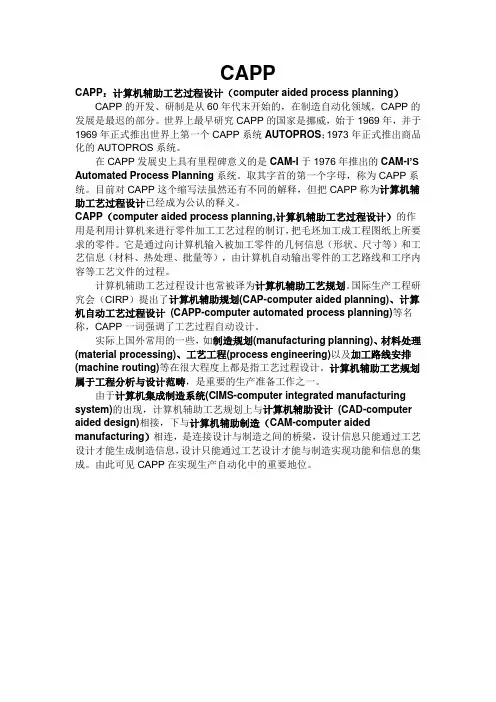
CAPPCAPP:计算机辅助工艺过程设计(computer aided process planning)CAPP的开发、研制是从60年代末开始的,在制造自动化领域,CAPP的发展是最迟的部分。
世界上最早研究CAPP的国家是挪威,始于1969年,并于1969年正式推出世界上第一个CAPP系统AUTOPROS;1973年正式推出商品化的AUTOPROS系统。
在CAPP发展史上具有里程碑意义的是CAM-I于1976年推出的CAM-I’S Automated Process Planning系统。
取其字首的第一个字母,称为CAPP系统。
目前对CAPP这个缩写法虽然还有不同的解释,但把CAPP称为计算机辅助工艺过程设计已经成为公认的释义。
CAPP(computer aided process planning,计算机辅助工艺过程设计)的作用是利用计算机来进行零件加工工艺过程的制订,把毛坯加工成工程图纸上所要求的零件。
它是通过向计算机输入被加工零件的几何信息(形状、尺寸等)和工艺信息(材料、热处理、批量等),由计算机自动输出零件的工艺路线和工序内容等工艺文件的过程。
计算机辅助工艺过程设计也常被译为计算机辅助工艺规划。
国际生产工程研究会(CIRP)提出了计算机辅助规划(CAP-computer aided planning)、计算机自动工艺过程设计(CAPP-computer automated process planning)等名称,CAPP一词强调了工艺过程自动设计。
实际上国外常用的一些,如制造规划(manufacturing planning)、材料处理(material processing)、工艺工程(process engineering)以及加工路线安排(machine routing)等在很大程度上都是指工艺过程设计。
计算机辅助工艺规划属于工程分析与设计范畴,是重要的生产准备工作之一。
由于计算机集成制造系统(CIMS-computer integrated manufacturing system)的出现,计算机辅助工艺规划上与计算机辅助设计(CAD-computer aided design)相接,下与计算机辅助制造(CAM-computer aided manufacturing)相连,是连接设计与制造之间的桥梁,设计信息只能通过工艺设计才能生成制造信息,设计只能通过工艺设计才能与制造实现功能和信息的集成。

ERP专业术语(英文缩写)ERR--企业资源计划(Enterprise Resour ce Planning).20世纪90年代MRP-II发展到了一个新的阶段:ERP (Enterprise ResourcePla nning —企业资源计划) 企业的所有资源简要地说包括三大流:物流、资金流、信息流,ERP 也就是对这三种资源进行全面集成管理的管理信息系统。
概括地说,ERP 是建立在信息技术基础上,利用现代企业的先进管理思想,全面地集成了企业所有资源信息,为企业提供决策、计划、控制与经营业绩评估的全方位和系统化的管理平台。
MRP n ---制造资源计划(Manufacturin g Resource Planning).1977年9月,由美国著名生产管理专家奥列弗怀特(Oliver W Wi ght )提出了一个新概念一一制造资源计划(Manufacturing Resources Planning ),称为MRP-II 。
MRP-II是对制造业企业资源进行有效计划的一整套方法。
它是一个围绕企业的基本经营目标,以生产计划为主线,对企业制造的各种资源进行统一的计划和控制,使企业的物流、信息流、资金流流动畅通的动态反馈系统。
MRP---物料需求计划(Material Requireme nts Pla nnin g).20世纪60年代,IBM公司的约瑟夫奥利佛博士提出了把对物料的需求分为独立需求与相关需求的概念:产品结构中物料的需求量是相关的。
在需要的时候提供需要的数量MPS---主生产计划(Master Production schedules).主生产计划(Master Production Sc hedule ,简称MPS )是确定每一具体的最终产品在每一具体时间段内生产数量的计划。
这里的最终产品是指对于企业来说最终完成、要出厂的完成品,它要具体到产品的品种、型号。
这里的具体时间段,通常是以周为单位,在有些情况下,也可以是日、旬、月。
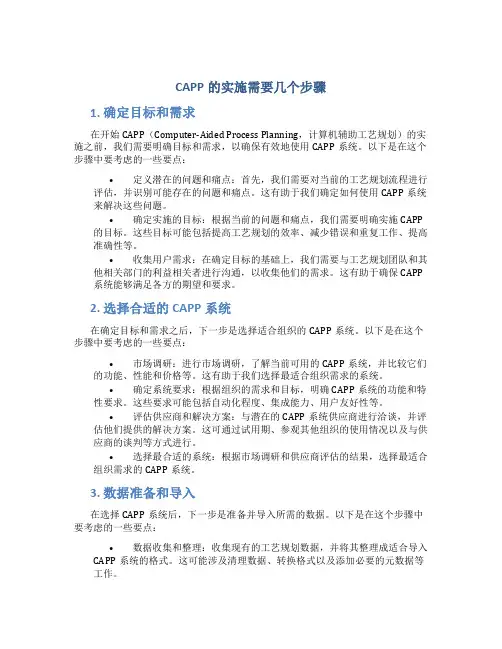
CAPP的实施需要几个步骤1. 确定目标和需求在开始CAPP(Computer-Aided Process Planning,计算机辅助工艺规划)的实施之前,我们需要明确目标和需求,以确保有效地使用CAPP系统。
以下是在这个步骤中要考虑的一些要点:•定义潜在的问题和痛点:首先,我们需要对当前的工艺规划流程进行评估,并识别可能存在的问题和痛点。
这有助于我们确定如何使用CAPP系统来解决这些问题。
•确定实施的目标:根据当前的问题和痛点,我们需要明确实施CAPP 的目标。
这些目标可能包括提高工艺规划的效率、减少错误和重复工作、提高准确性等。
•收集用户需求:在确定目标的基础上,我们需要与工艺规划团队和其他相关部门的利益相关者进行沟通,以收集他们的需求。
这有助于确保CAPP 系统能够满足各方的期望和要求。
2. 选择合适的CAPP系统在确定目标和需求之后,下一步是选择适合组织的CAPP系统。
以下是在这个步骤中要考虑的一些要点:•市场调研:进行市场调研,了解当前可用的CAPP系统,并比较它们的功能、性能和价格等。
这有助于我们选择最适合组织需求的系统。
•确定系统要求:根据组织的需求和目标,明确CAPP系统的功能和特性要求。
这些要求可能包括自动化程度、集成能力、用户友好性等。
•评估供应商和解决方案:与潜在的CAPP系统供应商进行洽谈,并评估他们提供的解决方案。
这可通过试用期、参观其他组织的使用情况以及与供应商的谈判等方式进行。
•选择最合适的系统:根据市场调研和供应商评估的结果,选择最适合组织需求的CAPP系统。
3. 数据准备和导入在选择CAPP系统后,下一步是准备并导入所需的数据。
以下是在这个步骤中要考虑的一些要点:•数据收集和整理:收集现有的工艺规划数据,并将其整理成适合导入CAPP系统的格式。
这可能涉及清理数据、转换格式以及添加必要的元数据等工作。
•数据格式转换:根据选定的CAPP系统的要求,将工艺规划数据转换成系统可接受的格式。
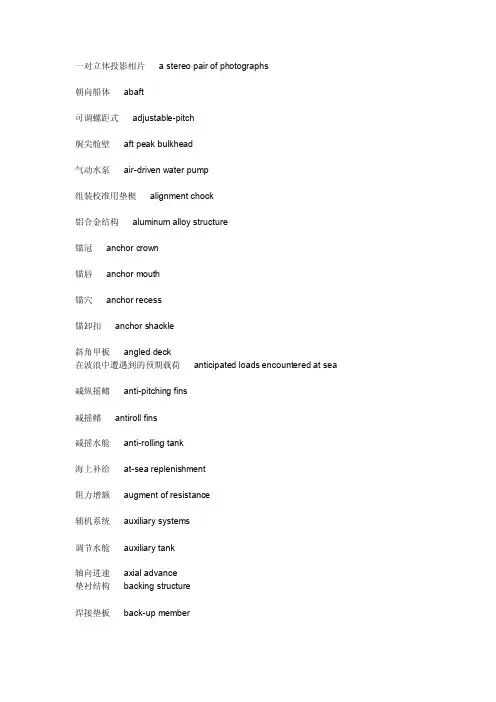
一对立体投影相片 a stereo pair of photographs朝向船体abaft可调螺距式adjustable-pitch艉尖舱壁aft peak bulkhead气动水泵air-driven water pump组装校准用垫楔alignment chock铝合金结构aluminum alloy structure锚冠anchor crown锚唇anchor mouth锚穴anchor recess锚卸扣anchor shackle斜角甲板angled deck在波浪中遭遇到的预期载荷anticipated loads encountered at sea 减纵摇鳍anti-pitching fins减摇鳍antiroll fins减摇水舱anti-rolling tank海上补给at-sea replenishment阻力增额augment of resistance辅机系统auxiliary systems调节水舱auxiliary tank轴向进速axial advance垫衬结构backing structure焊接垫板back-up member棒龙骨,方龙骨,矩形龙骨bar keel 基座纵桁bed-plate girder弯矩曲线bending-moment curves停泊期berth term舭,舱底bilge舭半径bilge radius舭部边舱水深探管bilge sounding pipe 叶跟blade root叶元剖面blade section出航旗blue peter登艇甲板boarding deck吊艇索boat fall稳艇索boat guy首斜尾拉索bobstay邦戎曲线Bonjean curve旁底桁bottom side girder底边舱bottom side tank艏波bow wave艏斜桅bowsprit艏侧推器bow-thruster制动曲柄brake crank arm制动液压缸brake hydraulic cylinder刹车液压管brake hydraulic pipe件杂货breakbulk艏肘板breasthook驾驶室集中操作台bridge console stand英国船舶研究协会BSRA组合型材built-up plate section球头扁钢bulb plate散货船bulk carrier散装油轮bulk oil carrier舷墙支撑bulwark stay航标船buoy tender浮箱buoyant box蝶形螺帽butterfly screw cap后体纵剖线buttock按照惯例,按约定by convention斜横梁cant beam舱容图capacity plan计算机辅助施工计划制定CAPP(computer –aided process planning) 束缚气泡减阻船captured-air-bubble vehicle货舱舱容,载货容积cargo cubic货物装卸cargo handling铸钢艏柱cast steel stem post中内龙骨center keelson制链器chain cable stopper租船人charterer舭,舷,脊chine计算机集成组合制造CIM(computer integrated manufacturing) 环流理论circulation theory飞剪型船首clipper bow沿海客货轮coastal cargo混合型艏柱combined cast and rolled stem营利用船commercial ship补给库舱室,粮食库commissary spaces交通船commuter概念设计concept design连接水柜connecting tank定螺距螺旋桨constant-pitch propeller对转桨contra-rotating propellers可控螺距式controllable-pitch船员居住舱crew quarters横越海峡车客渡轮cross-channel automobile ferries桅杆瞭望台crow’s nest巡洋舰尾cruiser stern各船形曲线curves of formPVC foamed plastic PV C泡沫塑料破损稳性damage stability卸除压载de-ballast甲板边线deck line at side甲板纵骨deck longitudinal舱面室,甲板室deckhouse型船体deep v hull 深v设计余量design margin设计螺旋循环方式design spiral散合式连接卸扣detachable shackle斜置加强筋diagonal stiffener无量纲比值dimensionless ratio排水型船displacement type vessel做功do work泊靠dock双重迭代法double iteration procedure双滚轮式导览钳double roller chock双向作用的蒸汽气缸double-acting steam cylinder 降帆索down halyard传动轴系driving shaft system导管螺旋桨ducted propeller动力支撑型船舶dynamic supported craft偏心轮eccentric wheel回声探深仪echo-sounder漩涡阻力eddy-making resistance电镀工electroplater高度,高程,船型线图的侧面图,立视图,纵剖线图,海拔elevations 封闭式装配车间enclosed fabrication shop封闭式救生艇enclosed lifeboat末端链环end open link末端卸扣end shackle机舱肋骨engine room frame机舱口端梁engine room hatch end beam船尾旗杆ensign staff延伸肘板expanded bracket升高肋板faised floor顺流变距桨叶feathering blade贴角焊连接fillet weld connection鳍角反馈装置fin angle feedback set纤细高速船fine fast ship瘦长船型fine form固定螺距式fixed-pitch侧翼舵flanking rudders襟翼舵flap-type rudder外飘,外张flare船队fleets of vessels可进长度曲线floodable length curve物流flow of materials平甲板型船flush deck vessel游艇驾驶台flying bridge艏三角帆flying jib折叠式舱口盖folding batch cover折叠收放式减摇鳍folding retractable fin stabilizer 随边following edge后续船following ship艏尖舱fore peak锻钢艏柱forged steel stem船首水尺forward draft mark艏艉柱forward/afer perpendicular翻砂铸造foundry casting淡水载重线fresh water loadline油水供给船fuel/water supply vessel丰满船型full form内装修furnishings前桅主帆gaff foresail甘特图gantt chart装以密封垫的开口gasketed openings杂货船general cargo ship外形相似船型geometrically similar form政府当局,管理机构governmental authorities槽式船坞graving dock绿皮书,19世纪英国另一船级社的船名录,现合并与劳埃德船级社,用于登录快速远洋船Green Book长吨(1.016公吨)gross ton导弹巡洋舰guided-missile cruiser舷边角钢gunwale angle舷边圆弧厚板gunwale rounded thick strake定位索guyline自动操舵操纵台gyro-pilot steering indicator半深纵骨half depth girder半圆扁钢half rounded flat plate舱口盖板隔架hatch cover rack舱口悬臂梁hatch side cantilever锚链桶hawse pipe锚链孔hawsehole螺旋面的,螺旋状的helicoidal艉部吊门hinged stern door英国皇家海军舰艇HMS均质柱状体homogeneous cylinder水平扶强材horizontal stiffener船型,船体外形hull form船体桁应力hull girder stress取暖,通风与冷却HVAC(heating ventilating and cooling)交互式计算机图像技术IAGG(interactive computer graphics)国际海事质询组织IMCO(Intergovernmental Maritime Consultative Organization) 内列板in strake增量塑性incremental plasticity独立舱柜independent tank小倾角初稳性initial stability at small angle of inclination内河船inland waterways vessel内底inner bottom面内载荷in-plane load完整稳性intact stability肋间的,加强的intercostals国际船模试验水池会议International T owing Tank Conference (ITTC)开始船舶建造keel laying双半式连接链环kenter shackle正摆线推进器Kristen-Boeing propelle(向水中)投放设备launching equipmeng导缘,导边leading edge升力风扇lift fan量取型值lift offsets空船light-ship舭部污水道顶板limbers board定期班轮营运业liner trade型线lines型线图lines plan林式等级式分类学Linnean hierarchical taxonomy 液化天然气船liquefied natural gas carrier液化石油气船liquefied petroleum gas carrier液体散货船liquid bulk cargo carrier液体化学品船liquid chemical tanker居住与公用舱室living and utility spaces劳埃德规范Lloyd’s Rules载重线公约Load Line Convention载重线公约,规范load line regulations载重水线面load waterplane放样台loft floor纵(横)稳心高longitudinal (transverse)纵向菱形系数longitudinal prismatic coefficient纵总强度longitudinal strength纵骨架式结构longitudinally framed system变幅绞车luffing winch机械(主机)卖方machinery vendor磁力式龙门吊magnet gantry主推叶轮main impeller主轴系main shafting大型船舶major ship速度调整标度盘mark disk of speed adjusting桅座mast clutch商船merchant ship商船建造统计表Merchant Shipbuilding Return金属板电镀槽metal plate path金属工metal worker舯横剖面midship section中横剖面系数midship section coefficient船模试验水池model tank主机操作监视台monitoring desk of main engine operation螺旋桨运转监视屏monitoring screen of screw working condition 船壳板的形状复杂more shape to the shell放样间mould loft多体船multihull vessel多用途船multi-purpose carrier多种船型建造规划multi-ship program蘑菇形通风桶mushroom ventilator相互排它性的属性mutually exclusive attribute航区navigation area航海甲板navigation deck准万向舵机,准万向齿轮near-universal gear静载荷曲线net-load curve不可收放式减摇鳍non-retractable fin stabilizer 螺旋桨整流帽nose cone橹,桨oar斜式双柱系缆桩oblique bitts远洋船ocean going ship偏离中心的装载off-center loading钻油架oil-rig甲板上桁架on-deck girder矿砂船ore carrier外列板out strake舷外机outboard motor外首帆outer jib舾装工outfitter总体稳性overall stability明轮推进的paddle-wheel-propelled强胸结构,抗拍击结构panting arrangement 抗拍击纵材panting stringer局部舱壁partial bulkhead限位胎架pin jig管装工pipe fitter滑行船体planning hull普林索尔载重线Plimsoll line极地考察船polar-exploration craft沿途到港停靠port call正扶正力矩positive righting moment动力与照明系统power and lighting system阻力式舱口防水挡板pressure coaming主尺度principal dimensions累进进水progressive flooding尾轴架propeller shaft bracket螺旋桨推进器测程仪propeller type log舱内侧梁柱quarter pillar准定长波quasi-steady wave报价单quotation前倾式船首raked bow冷藏货物运输船refrigerated cargo ship燃油压力调节钮regulating knob of fuel pressure 储备浮力reserve buoyancy内底横骨reverse frame右旋进桨right-handed propeller刚性侧壁rigid side walls底升rise of floor内河舰艇riverine warfare vessel滚装roll-on/roll-off (Ro/Ro)回转式螺旋推进器rotary screw propeller修圆的舷边rounded gunwale圆弧舷板rounded sheer strake操舵杆rudder control rod舵钮rudder gudgeon舵销rudder pintle舵轴rudder spindle舵杆围井rudder trunk救捞船salvage lifting vessel生产规程协调schedule coordination施工生产进度审核schedule reviews轻型舱壁screen bulkhead耐波性能Sea keeping performance海浪谱sea spectra剖面模数section moulus剖面,横剖面sectiongs自航self-propulsion半潜式钻井架semi-submersible drilling rig 剪切性屈曲shear buckling剪力曲线shear curve艉舷弧sheer aft艏舷弧sheer forward总剖线sheer profile船壳板shell plating船舶装配工ship fitter船舶水动力学ship hydrodynamics有套罩螺旋桨,导管螺旋桨shrouded screw舷边肋骨side frame舷侧外板side plate单缸引擎single-cylinder engine六自由度six degrees of freedom回转液压马达slewing hydraulic motor有坡度船台sloping shipway底边舱斜顶板sloping top plate of bottom side tank 定边舱斜底板slopint bottom plate of topside tank 圆舭soft chine悬挂舵spade rudder眼睛型骨架spectacle frame速长比speed-to-length ratio汽轮船steamer操纵装置,舵机steering gear艏柱型线stem contour尾拖网滚筒stern barrel尾突体stern counter尾滑道,尾跳板stern ramp尾封板stern transom plate加劲,加强stiffen流线型套管streamlined casing强度曲线strength curves强力甲板strength deck结构不稳定性structural instability桨叶片抽吸叶背suction back of a blade苏伊士运河吨位限制Suez Canal tonnage夏季载重水线summer load water line船级社验船师的监造书Supervision of the Society’s surveyor 超空泡螺旋桨supper cavitating propeller水面式喷口surface nozzle穿透水面的surface piercing表面加工处理与喷涂surface preparation and coating压筋板swage plate小水线面双体船SWATH (Small Waterplane Area Twin Hull) 尾翼式锚tail-stabilizer anchor讨论文件talking paper切向粘性力tangential viscous force推力器,助推器thruster木材运输船timber carrier桨叶叶梢tip of a blade梢涡tip vortex趾部朝向船舯toed towards amidships横隔舱壁板transverse bulkhead plating横稳性transverse stability艉艏倾trim by the stern/bow三体的trimaran防倾肘板tripping bracket(船侧)内倾tumble home水桶壁面效应tunnel wall effect可转动式桨叶turnable blade甲板间舱tweendeck cargo space甲板间肋骨tweendedk frame双节点频率two nodded frequencytee T型构件,三通管正浮位置upright position气化阱vapor pocket通风与空调铺设设计图ventilation and air conditioning diagram 文丘里试验段Venturi section横剖面系数vertical prismatic coefficient直叶(摆线)推进器vertical-axis(cycloidal)propeller造船部件销售商vessel component vender巨型原油轮VLCC外摆线直翼式推进器Voith-Schneider propeller伴流,尾流wake current水线面water plane水密完整性watertight integrity消波器,消波板wave suppressor兴波阻力wave-making resistance强横梁web beam腹肋板web frame侧轴wing shaft翅龙骨(游艇)wing-keel有效使用修正量working allowanceradiography X射线探伤船厂开工任务发布书yard issue船体部分1、1结构 Structure1 2船厂dockyard/shipyard船坞dock/boatyard船东ship-owner 船舷Ship's side船码头quay/dock船的栏杆Ship's rail船舱hold甲板Deck船籍Ship's registry住舱甲板accommodation deck 船首bow梁拱甲板arch deck船梯ladder载货甲板cargo deck船尾stern首楼甲板Forecastle deck上甲板Upper deck下甲板Lower deck主甲板Main deck货舱甲板Hold deck桥楼甲板Bridge deck水密甲板Watertight deck34驾驶甲板Navigation deck铜-钢复合板Copper sheathingsteel plate艇甲板Boat deck甲板边板Deck stringer plate 罗经甲板Compass deck斜板Sloping plate板Plate加强板Reinforcement plate 舭板Bilge plate舵板Rudder plate船底板Bottom plate舷侧外板Side plate船外板Shell plate裙板Skirt plate船首外板Bow plate首柱板Stem plate肘板Bracket plate首柱板Stern plate舱壁板Bulkhead plate平台platform槽形舱壁板Corrugated bulkheadplate机舱平台Engine-room platform舷墙板Bulwark plate分段Block围板Coaming plate首段Bow block连续板Connection plate中段Midship block56尾段Stern block甲板下纵桁Underdeck girder 左舷port舭纵桁Wing girder右舷Starboard支柱Pillar纵桁Girder肋骨Frame型材桁Bar girder基础台架Base frame中底桁Bottom center girder支架Bear frame中内龙骨Bottom center linegirder舭肋骨Bilge frame底桁材Bottom girder船底肋骨Bottom frame 旁桁材Bottom side girder首肋骨Bow frame甲板纵桁Deck girder 肘板框架肋骨Bracket frame横桁Cross girder球鼻首肋骨Bulbous bow frame 水平桁Horizontal girder球曲型肋骨Bulbous frame舱口边梁Hatch coaming girder主肋骨Chief frame机座纵桁Engine girder首肋骨Fore frame7桁架梁Girder frame 舭纵桁舭纵骨Bilge longitudinal舯部肋骨Middle frame 船底纵骨/纵桁bottom longitudinal尖舱肋骨Peak frame船底腹板纵bottom web桁longitudinal加强筋Stiffened frame甲板纵桁Deck longitudinal横框架肋骨Transverse frame 内底纵桁/纵骨Inner bottomlongitudinal肋距 F.S.(frame space)舷侧纵桁/纵骨Shell sidelongitudinal纵桁/纵骨/纵向构件longitudinal双层底顶纵骨Top longitudinal ofdouble bottom89斜舱壁纵骨Slopping-bulkheadlongitudinal舱Tank结构Structure尾尖舱after peak tank附属结构Accessory structure尾部水舱after water tank全焊结构All-welded structure辅助水柜Auxiliary water tank中部结构Amidships structure 辅助压载水舱Auxiliary waterballast tank泊位结构Berthing structure污水舱Bilge tank底部龙骨结构Bottom keel structure底舱Bottom tank船首部结构Bow structure底边舱Bottom side tank支撑结构Braced structure货油压载舱Cargo and ballast tank桥楼结构Bridge structure循环水槽Circulating flow water tank首楼结构Forecastle structure循环滑油舱Circulating lubricating oil tank构架结构Framed structure清洁压载舱Clean ballast tank 纵桁结构Girder structure冷凝水柜Condensate catch tank 人孔manhole干舱Dry tank。
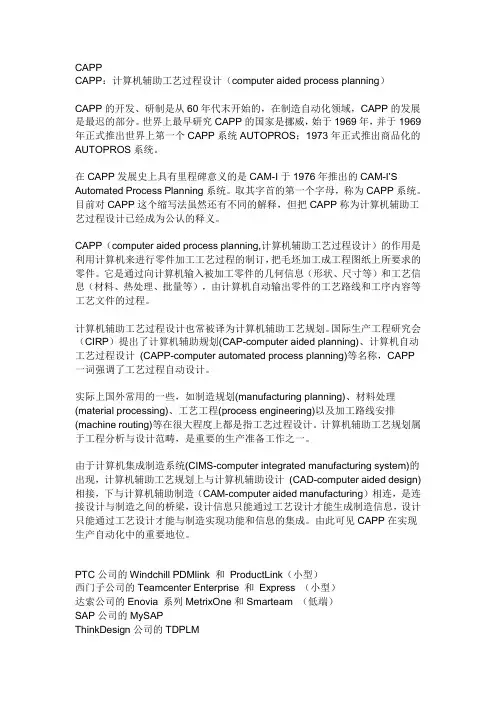
CAPPCAPP:计算机辅助工艺过程设计(computer aided process planning)CAPP的开发、研制是从60年代末开始的,在制造自动化领域,CAPP的发展是最迟的部分。
世界上最早研究CAPP的国家是挪威,始于1969年,并于1969年正式推出世界上第一个CAPP系统AUTOPROS;1973年正式推出商品化的AUTOPROS系统。
在CAPP发展史上具有里程碑意义的是CAM-I于1976年推出的CAM-I’S Automated Process Planning系统。
取其字首的第一个字母,称为CAPP系统。
目前对CAPP这个缩写法虽然还有不同的解释,但把CAPP称为计算机辅助工艺过程设计已经成为公认的释义。
CAPP(computer aided process planning,计算机辅助工艺过程设计)的作用是利用计算机来进行零件加工工艺过程的制订,把毛坯加工成工程图纸上所要求的零件。
它是通过向计算机输入被加工零件的几何信息(形状、尺寸等)和工艺信息(材料、热处理、批量等),由计算机自动输出零件的工艺路线和工序内容等工艺文件的过程。
计算机辅助工艺过程设计也常被译为计算机辅助工艺规划。
国际生产工程研究会(CIRP)提出了计算机辅助规划(CAP-computer aided planning)、计算机自动工艺过程设计(CAPP-computer automated process planning)等名称,CAPP一词强调了工艺过程自动设计。
实际上国外常用的一些,如制造规划(manufacturing planning)、材料处理(material processing)、工艺工程(process engineering)以及加工路线安排(machine routing)等在很大程度上都是指工艺过程设计。
计算机辅助工艺规划属于工程分析与设计范畴,是重要的生产准备工作之一。
由于计算机集成制造系统(CIMS-computer integrated manufacturing system)的出现,计算机辅助工艺规划上与计算机辅助设计(CAD-computer aided design)相接,下与计算机辅助制造(CAM-computer aided manufacturing)相连,是连接设计与制造之间的桥梁,设计信息只能通过工艺设计才能生成制造信息,设计只能通过工艺设计才能与制造实现功能和信息的集成。
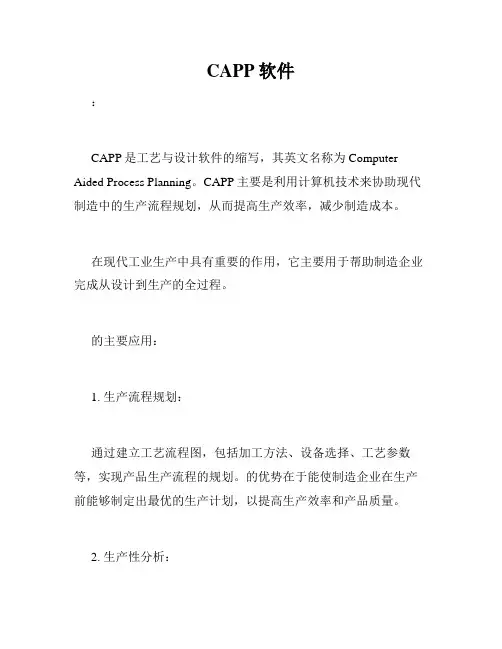
CAPP软件
:
CAPP是工艺与设计软件的缩写,其英文名称为Computer Aided Process Planning。
CAPP主要是利用计算机技术来协助现代制造中的生产流程规划,从而提高生产效率,减少制造成本。
在现代工业生产中具有重要的作用,它主要用于帮助制造企业完成从设计到生产的全过程。
的主要应用:
1. 生产流程规划:
通过建立工艺流程图,包括加工方法、设备选择、工艺参数等,实现产品生产流程的规划。
的优势在于能使制造企业在生产前能够制定出最优的生产计划,以提高生产效率和产品质量。
2. 生产性分析:
能够对生产中的资料、生产线及生产过程进行类比分析,以达到生产效率的最优化。
3. 计算优化:
具有计算机辅助的特性,当产品设计改动后可以自动更新生产计划并进行计算分析。
4. 自动编程:
能根据产品设计来自动生成生产工艺流程图,并自动编程生成指令代码。
具有很高的实用价值,它可以让生产计划更快速、更科学,生产更优质和更高效率。
尤其对于大批量生产的企业来说,能大大提高生产效率,节约人力和物力资源,优化生产过程。
结论:
现在,CAPP已经成为了国际先进生产管理的重要方式,许多国外的企业都广泛地使用来优化生产流程和生产效率。
作为中国制造业发展的重要手段之一,的发展前景非常广阔。
我相信,随着科技的发展和我国制造业的提升,的市场应用将会越来越广泛,也将成为中国制造企业优化生产流程和降低成本的重要手段之一。
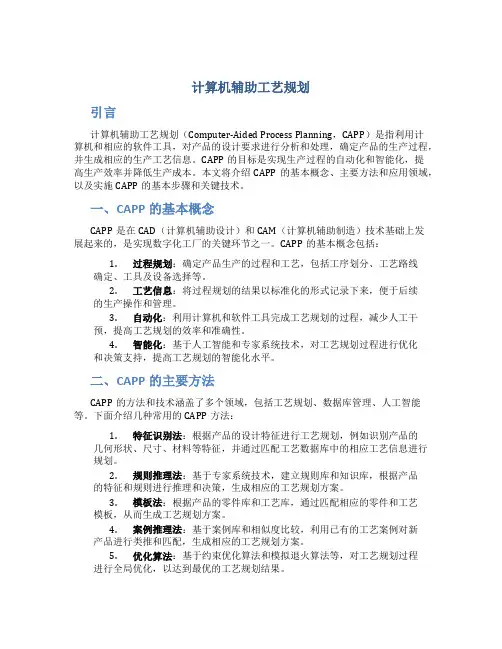
计算机辅助工艺规划引言计算机辅助工艺规划(Computer-Aided Process Planning,CAPP)是指利用计算机和相应的软件工具,对产品的设计要求进行分析和处理,确定产品的生产过程,并生成相应的生产工艺信息。
CAPP的目标是实现生产过程的自动化和智能化,提高生产效率并降低生产成本。
本文将介绍CAPP的基本概念、主要方法和应用领域,以及实施CAPP的基本步骤和关键技术。
一、CAPP的基本概念CAPP是在CAD(计算机辅助设计)和CAM(计算机辅助制造)技术基础上发展起来的,是实现数字化工厂的关键环节之一。
CAPP的基本概念包括:1.过程规划:确定产品生产的过程和工艺,包括工序划分、工艺路线确定、工具及设备选择等。
2.工艺信息:将过程规划的结果以标准化的形式记录下来,便于后续的生产操作和管理。
3.自动化:利用计算机和软件工具完成工艺规划的过程,减少人工干预,提高工艺规划的效率和准确性。
4.智能化:基于人工智能和专家系统技术,对工艺规划过程进行优化和决策支持,提高工艺规划的智能化水平。
二、CAPP的主要方法CAPP的方法和技术涵盖了多个领域,包括工艺规划、数据库管理、人工智能等。
下面介绍几种常用的CAPP方法:1.特征识别法:根据产品的设计特征进行工艺规划,例如识别产品的几何形状、尺寸、材料等特征,并通过匹配工艺数据库中的相应工艺信息进行规划。
2.规则推理法:基于专家系统技术,建立规则库和知识库,根据产品的特征和规则进行推理和决策,生成相应的工艺规划方案。
3.模板法:根据产品的零件库和工艺库,通过匹配相应的零件和工艺模板,从而生成工艺规划方案。
4.案例推理法:基于案例库和相似度比较,利用已有的工艺案例对新产品进行类推和匹配,生成相应的工艺规划方案。
5.优化算法:基于约束优化算法和模拟退火算法等,对工艺规划过程进行全局优化,以达到最优的工艺规划结果。
三、CAPP的应用领域CAPP广泛应用于各个制造行业,包括机械制造、航空航天、汽车制造等。

计算机辅助工艺规程设计(CAPP)概述摘要:计算机辅助工艺过程设计(Computer Aided Process Planning,简称CAPP)是通过计算机技术辅助工艺设计人员,以系统、科学的方法确定零件从毛坯到成品的整个技术过程,即工艺规程。
是连接CAD系统和CAM系统的桥梁,在产品设计和制造整个过程的重要角色。
本文介绍了国内外的CAPP的发展历程,CAPP的基本组成部分和关键技术以及目前存在的问题。
关键词:计算机辅助工艺规程设计(CAPP),工艺决策,成组技术1.CAPP的基本概念计算机辅助工艺规程设计(Computer Aided Process Planning,简称CAPP)是通过计算机技术辅助工艺设计人员,以系统、科学的方法确定零件从毛坯到成品的整个技术过程,即工艺规程。
通常是指机械产品制造工艺过程的计算机辅助设计与文档编制。
CAPP系统的主要任务是通过计算机辅助工艺过程设计完成产品设计信息向制造信息的传递、是连接CAD与CAM的桥梁。
CAPP就是计算机的信息处理和信息管理优势,采用先进的信息处理技术和智能技术,帮助工艺设计人员完成工艺设计中的各项任务,如选择定位基准、拟订零件加工工艺路线、确定各工序的加工余量、计算工艺尺寸和公差、选择加工设备和工艺装置、确定切削用量、确定重要工序的质量检测项目和检测方法、计算工时定额、编写各类工艺文件等,最后生成产品生产所需的各种工艺文件和数控加工编程、生产计划制定和作业计划制定所需的相关数据信息,作为数控加工程序的编制、生产管理与运行控制系统执行的基础信息。
CAPP是将产品设计信息转换为各种加工制造、管理信息的关键环节,是企业信息化建设中联系设计和生产的纽带,同时也为企业的管理部门提供相关的数据,是企业信息交换的中间环节。
在企业生产中,工艺设计处于产品设计和加工制造的接口处,必须分析和处理大量信息。
既要考虑产品设计图样上有关零件结构形状、尺寸公差、材料及批量等方面的信息,又要了解加工制造中有关加工方法、加工设备、生产条件、加工成本及工时定额、甚至传统习惯等方面的信息,因此,工艺设计是一个典型的复杂问题。
CAD (Computer Aided Design,简称CAD)计算机辅助设计CAM (Computer Aided Manufacture)计算机辅助制造CAPP Computer Aided Process Planning,简称CAPP。
计算机辅助工艺规程设计CAE (Computer Aided Engineering,简称CAE) 计算机辅助工程分析ERP (Enterprise resource plan)企业资源计划PDM产品数据管理 Product Data Management以产品为中心,通过计算机网络和数据库技术,把企业生产过程中所有与产品相关的信息和过程集成起来进行管理的技术。
BPR (Business Process Reengineering企业流程再造):从根本上的重新考虑并彻底重新设计业务流程,以实现在关键的业绩上,如成本、质量、服务和响应速度,取得突破性的进展。
BOM物料清单 (Bill of Materials)它是一种描述装配件的结构化的零件表,其中包括所有的子装配件、零件、原材料的清单,以及制造一个装配件所需物料的数量,如工时、材料、设备、工装、车间等。
MRP 物料需求计划(Material Requirement Planning)的简称。
MRP是一种将库存管理和生产进度计划结合为一体的计算机辅助生产计划管理系统。
它以减少库存量为目标,统筹地为制造业管理者提供满足生产计划需要的物资供应手段。
MRPII 制造资源计划(Manufacturing Resource Planning)的简称。
是在物料需求计划(MRP)的基础上发展起来的。
它不仅编制产品和零部件的生产进度计划、物料采购计划,而且还可以直接从系统获得各种财务信息如销售收入、库存资金占用量和产品成本等。
是一个覆盖企业全部生产资源的管理信息系统。
SCM 供应链管理(Supply Chain Management)的简称。
船舶专业英语词汇船舶专业英语词汇(按照字母顺序排列)(一)a faired set of lines 经过光顺处理的一套型线a stereo pair of photographs 一对立体投影相片abaft 朝向船体abandonment cost 船舶废置成本费用accommodation 居住(舱室)accommodation ladder 舷梯adjust valve 调节阀adjustable-pitch 可调螺距式admiralty 海军部advance coefficient 进速系数aerostatic 空气静力学的aft peak bulkhead 艉尖舱壁aft peak tank 艉尖舱aileron 副鳍air cushion vehicle 气垫船air diffuser 空气扩散器air intake 进气口aircraft carrier 航空母舰air-driven water pump 气动水泵airfoil 气翼,翼剖面,机面,方向舵alignment chock 组装校准用垫楔aluminum alloy structure 铝合金结构American Bureau of Shipping 美国船级社amidships 舯amphibious 两栖的anchor arm 锚臂anchor chain 锚链anchor crown 锚冠anchor fluke 锚爪anchor mouth 锚唇anchor shackle 锚卸扣anchor stock 锚杆angle bar 角钢angle of attack 攻角angle plate 角钢angled deck 斜角甲板anticipated loads encountered at sea 在波浪中遭遇到的预期载荷anti-pitching fins 减纵摇鳍antiroll fins 减摇鳍anti-rolling tank 减摇水舱appendage 附体artisan 技工assembly line 装配流水线at-sea replenishment 海上补给augment of resistance 阻力增额auxiliary systems 辅机系统auxiliary tank 调节水舱axial advance 轴向进速backing structure 垫衬结构back-up member 焊接垫板balance weight 平衡锤ball bearing 滚珠轴承ball valve 球阀ballast tank 压载水舱bar 型材bar keel 棒龙骨,方龙骨,矩形龙骨barge 驳船baseline 基线basic design 基本设计batten 压条,板条beam 船宽,梁beam bracket 横梁肘板beam knee 横梁肘板bed-plate girder 基座纵桁精品文库Benoulli’s law 伯努利定律berth term 停泊期bevel 折角bidder 投标人bilge 舭,舱底bilge bracket 舭肘板bilge radius 舭半径bilge sounding pipe 舭部边舱水深探管bitt 单柱系缆桩blade root 叶跟blade section 叶元剖面blast 喷丸block coefficient 方形系数blue peter 出航旗boarding deck 登艇甲板boat davit 吊艇架boat fall 吊艇索boat guy 稳艇索bobstay 首斜尾拉索body plan 横剖面图bolt 螺栓,上螺栓固定Bonjean curve 邦戎曲线boom 吊杆boss 螺旋桨轴榖bottom side girder 旁底桁bottom side tank 底边舱bottom transverse 底列板boundary layer 边界层bow line 前体纵剖线bow wave 艏波bowsprit 艏斜桅bow-thruster 艏侧推器box girder 箱桁bracket floor 框架肋板brake 制动装置brake band 制动带brake crank arm 制动曲柄brake drum 刹车卷筒brake hydraulic cylinder 制动液压缸brake hydraulic pipe 刹车液压管breadth extreme 最大宽,计算宽度breadth moulded 型宽breakbulk 件杂货breasthook 艏肘板bridge 桥楼,驾驶台bridge console stand 驾驶室集中操作台BSRA 英国船舶研究协会buckle 屈曲buffer spring 缓冲弹簧built-up plate section 组合型材bulb plate 球头扁钢bulbous bow 球状船艏,球鼻首bulk carrier 散货船bulk oil carrier 散装油轮bulkhead 舱壁bulwark 舷墙bulwark plate 舷墙板bulwark stay 舷墙支撑buoy tender 航标船buoyant 浮力的buoyant box 浮箱Bureau Veritas 法国船级社butt weld 对缝焊接butterfly screw cap 蝶形螺帽buttock 后体纵剖线by convention 按照惯例,按约定船舶专业英语词汇(按照字母顺序排列)(二)cable ship 布缆船cable winch 钢索绞车CAD(computer-aided design) 计算机辅助设计CAE(computer-aided manufacturing) 计算机辅助制造CAM(computer-aided engineering) 计算机辅助工程camber 梁拱cant beam 斜横梁cant frame 斜肋骨cantilever beam 悬臂梁capacity plan 舱容图CAPP(computer –aided process planning) 计算机辅助施工计划制定capsize 倾覆capsizing moment 倾覆力臂captain 船长captured-air-bubble vehicle 束缚气泡减阻船cargo cubic 货舱舱容,载货容积cargo handling 货物装卸carriage 拖车,拖架cast steel stem post 铸钢艏柱catamaran 高速双体船catamaran 双体的cavitation 空泡cavitation number 空泡数cavitation tunnel 空泡水筒center keelson 中内龙骨centerline bulkhead 中纵舱壁centroid 型心,重心,质心,矩心chain cable stopper 制链器chart 海图charterer 租船人chief engineer 轮机长chine 舭,舷,脊chock 导览钳CIM(computer integrated manufacturing) 计算机集成组合制造circulation theory 环流理论classification society 船级社cleat 系缆扣clipper bow 飞剪型船首clutch 离合器coastal cargo 沿海客货轮cofferdam 防撞舱壁combined cast and rolled stem 混合型艏柱commercial ship 营利用船commissary spaces 补给库舱室,粮食库common carrier 通用运输船commuter 交通船compartment 舱室compass 罗经concept design 概念设计connecting tank 连接水柜constant-pitch propeller 定螺距螺旋桨constraint condition 约束条件container 集装箱containerized 集装箱化contract design 合同设计contra-rotating propellers 对转桨controllable-pitch 可控螺距式corrosion 锈蚀,腐蚀couple 力矩,力偶crane 克令吊,起重机crank 曲柄crest (of wave) 波峰crew quarters 船员居住舱criterion 判据,准则Critical Path Method 关键路径法cross-channel automobile ferries 横越海峡车客渡轮cross-sectional area 横剖面面积crow’s nest 桅杆瞭望台cruiser stern 巡洋舰尾crussing range 航程cup and ball joint 球窝关节curvature 曲率curves of form 各船形曲线cushion of air 气垫damage stability 破损稳性damper 缓冲器damping 阻尼davit arm 吊臂deadweight 总载重量de-ballast 卸除压载deck line at side 甲板边线deck longitudinal 甲板纵骨deck stringer 甲板边板deck transverse 强横梁deckhouse 舱面室,甲板室deep v hull 深v型船体delivery 交船depth 船深derrick 起重机,吊杆design margin 设计余量design spiral 设计螺旋循环方式destroyer 驱逐舰detachable shackle 散合式连接卸扣detail design 详细设计diagonal stiffener 斜置加强筋diagram 图,原理图,设计图diesel engine 柴油机dimensionless ratio 无量纲比值displacement 排水量displacement type vessel 排水型船distributed load 分布载荷division 站,划分,分隔do work 做功dock 泊靠double hook 山字钩double iteration procedure 双重迭代法double roller chock 双滚轮式导览钳double-acting steam cylinder 双向作用的蒸汽气缸down halyard 降帆索draft 吃水drag 阻力,拖拽力drainage 排水draught 吃水,草图,设计图,牵引力dredge 挖泥船drift 漂移,偏航drilling rig 钻架drillship 钻井船drive shaft 驱动器轴driving gear box 传动齿轮箱driving shaft system 传动轴系dry dock 干船坞ducted propeller 导管螺旋桨dynamic supported craft 动力支撑型船舶dynamometer 测力计,功率计船舶专业英语词汇(按照字母顺序排列)(三)e.h.p 有效马力eccentric wheel 偏心轮echo-sounder 回声探深仪eddy 漩涡eddy-making resistance 漩涡阻力efficiency 供给能力,供给量electrohydraulic 电动液压的electroplater 电镀工elevations 高度,高程,船型线图的侧面图,立视图,纵剖线图,海拔empirical formula 经验公式enclosed fabrication shop 封闭式装配车间enclosed lifeboat 封闭式救生艇end open link 末端链环end shackle 末端卸扣endurance 续航力endurance 续航力,全功率工作时间engine room frame 机舱肋骨engine room hatch end beam 机舱口端梁ensign staff 船尾旗杆entrance 进流段erection 装配,安装exhaust valve 排气阀expanded bracket 延伸肘板expansion joint 伸缩接头extrapolate 外插fair 光顺faised floor 升高肋板fan 鼓风机fatigue 疲劳feasibility study 可行性研究feathering blade 顺流变距桨叶fender 护舷ferry 渡轮,渡运航线fillet weld connection 贴角焊连接fin angle feedback set 鳍角反馈装置fine fast ship 纤细高速船fine form 瘦长船型finite element 有限元fire tube boiler 水火管锅炉fixed-pitch 固定螺距式flange 突边,法兰盘flanking rudders 侧翼舵flap-type rudder 襟翼舵flare 外飘,外张flat of keel 平板龙骨fleets of vessels 船队flexural 挠曲的floating crane 起重船floodable length curve 可进长度曲线flow of materials 物流flow pattern 流型,流线谱flush deck vessel 平甲板型船flying bridge 游艇驾驶台flying jib 艏三角帆folding batch cover 折叠式舱口盖folding retractable fin stabilizer 折叠收放式减摇鳍following edge 随边following ship 后续船foot brake 脚踏刹车fore peak 艏尖舱forged steel stem 锻钢艏柱forging 锻件,锻造forward draft mark 船首水尺forward/afer perpendicular 艏艉柱forward/after shoulder 前/后肩foundry casting 翻砂铸造frame 船肋骨,框架,桁架freeboard 干舷freeboard deck 干舷甲板freight rate 运费率fresh water loadline 淡水载重线frictional resistance 摩擦阻力Froude number 傅汝德数fuel/water supply vessel 油水供给船精品文库full form丰满船型full scale 全尺度fullness 丰满度funnel 烟囱furnishings 内装修gaff 纵帆斜桁gaff foresail 前桅主帆gangway 舷梯gantt chart 甘特图gasketed openings 装以密封垫的开口general arrangement 总布置general cargo ship 杂货船generatrix 母线geometrically similar form 外形相似船型girder 桁梁,桁架girder of foundation 基座纵桁governmental authorities 政府当局,管理机构gradient 梯度graving dock 槽式船坞Green Book 绿皮书,19世纪英国另一船级社的船名录,现合并与劳埃德船级社,用于登录快速远洋船gross ton 长吨(1.016公吨)group technology 成祖建造技术GT 成组建造技术guided-missile cruiser 导弹巡洋舰gunwale 船舷上缘gunwale angle 舷边角钢gunwale rounded thick strake 舷边圆弧厚板guyline 定位索gypsy 链轮gyro-pilot steering indicator 自动操舵操纵台gyroscope 回转仪船舶专业英语词汇(按照字母顺序排列)(四)half breadth plan 半宽图half depth girder 半深纵骨half rounded flat plate 半圆扁钢hard chine 尖舭hatch beam sockets 舱口梁座hatch coaming 舱口围板hatch cover 舱口盖hatch cover 舱口盖板hatch cover rack 舱口盖板隔架hatch side cantilever 舱口悬臂梁hawse pipe 锚链桶hawsehole 锚链孔heave 垂荡heel 横倾heel piece 艉柱根helicoidal 螺旋面的,螺旋状的hinge 铰链hinged stern door 艉部吊门HMS 英国皇家海军舰艇hog 中拱hold 船舱homogeneous cylinder 均质柱状体hopper barge 倾卸驳horizontal stiffener 水平扶强材hub 桨毂,轴毂,套筒hull form 船型,船体外形hull girder stress 船体桁应力HVAC(heating ventilating and cooling) 取暖,通风与冷却hydraulic mechanism 液压机构hydrodynamic 水动力学的hydrofoil 水翼hydrostatic 水静力的IAGG(interactive computer graphics) 交互式计算机图像技术icebreaker 破冰船icebreaker 破冰船IMCO(Intergovernmental Maritime Consultative Organ ization) 国际海事质询组织immerse 浸水,浸没impact load 冲击载荷imperial unit 英制单位in strake 内列板inboard profile 纵剖面图incremental plasticity 增量塑性independent tank 独立舱柜initial stability at small angle of inclination 小倾角初稳性inland waterways vessel 内河船inner bottom 内底in-plane load 面内载荷intact stability 完整稳性intercostals 肋间的,加强的International Association of Classification Society (IA CS) 国际船级社联合会International Towing Tank Conference (ITTC) 国际船模试验水池会议intersection 交点,交叉,横断(切)inventory control 存货管理iterative process 迭代过程jack 船首旗jack 千斤顶joinery 细木工keel 龙骨keel laying 开始船舶建造kenter shackle 双半式连接链环Kristen-Boeing propeller 正摆线推进器landing craft 登陆艇launch 发射,下水launch 汽艇launching equipmeng (向水中)投放设备LCC 大型原油轮leading edge 导缘,导边ledge 副梁材length overall 总长leveler 调平器,矫平机life saving appliance 救生设备lifebuoy 救生圈lifejacket 救生衣lift fan 升力风扇lift offsets 量取型值light load draft 空载吃水lightening hole 减轻孔light-ship 空船limbers board 舭部污水道顶板liner trade 定期班轮营运业lines 型线lines plan 型线图Linnean hierarchical taxonomy 林式等级式分类学liquefied gas carrier 液化气运输船liquefied natural gas carrier 液化天然气船liquefied petroleum gas carrier 液化石油气船liquid bulk cargo carrier 液体散货船liquid chemical tanker 液体化学品船list 倾斜living and utility spaces 居住与公用舱室Lloyd’s Register of shipping 劳埃德船级社Lloyd’s Rules 劳埃德规范Load Line Convention 载重线公约load line regulations 载重线公约,规范load waterplane 载重水线面loft floor 放样台longitudinal (transverse) 纵(横)稳心高longitudinal bending 纵总弯曲longitudinal prismatic coefficient 纵向菱形系数longitudinal strength 纵总强度longitudinally framed system 纵骨架式结构luffing winch 变幅绞车machinery vendor 机械(主机)卖方magnet gantry 磁力式龙门吊maiden voyage 处女航main impeller 主推叶轮main shafting 主轴系major ship 大型船舶maneuverability 操纵性manhole 人孔margin plate 边板maritime 海事的,海运的,靠海的mark disk of speed adjusting 速度调整标度盘mast 桅杆mast clutch 桅座matrix 矩阵merchant ship 商船Merchant Shipbuilding Return 商船建造统计表metacenter 稳心metacentric height 稳心高metal plate path 金属板电镀槽metal worker 金属工metric unit 公制单位middle line plane 中线面midship section 舯横剖面midship section coefficient 中横剖面系数ML 物资清单,物料表model tank 船模试验水池monitoring desk of main engine operation 主机操作监视台monitoring screen of screw working condition 螺旋桨运转监视屏more shape to the shell 船壳板的形状复杂mould loft 放样间multihull vessel 多体船multi-purpose carrier 多用途船multi-ship program 多种船型建造规划mushroom ventilator 蘑菇形通风桶mutually exclusive attribute 相互排它性的属性船舶专业英语词汇(按照字母顺序排列)(五)N/C 数值控制nautical mile 海里naval architecture 造船学navigation area 航区navigation deck 航海甲板near-universal gear 准万向舵机,准万向齿轮net-load curve 静载荷曲线neutral axis 中性轴,中和轴neutral equilibrium 中性平衡non-retractable fin stabilizer 不可收放式减摇鳍normal 法向的,正交的normal operating condition 常规运作状况nose cone 螺旋桨整流帽notch 开槽,开凹口oar 橹,桨oblique bitts 斜式双柱系缆桩ocean going ship 远洋船off-center loading 偏离中心的装载offsets 型值offshore drilling 离岸钻井offshore structure 离岸工程结构物oil filler 加油点oil skimmer 浮油回收船oil-rig 钻油架on-deck girder 甲板上桁架open water 敞水optimality criterion 最优性准则ore carrier 矿砂船orthogonal 矩形的orthogonal 正交的out strake 外列板outboard motor 舷外机outboard profile 侧视图outer jib 外首帆outfit 舾装outfitter 舾装工outrigger 舷外吊杆叉头overall stability 总体稳性overhang 外悬paddle 桨paddle-wheel-propelled 明轮推进的Panama Canal 巴拿马运河panting arrangement 强胸结构,抗拍击结构panting beam 强胸横梁panting stringer 抗拍击纵材parallel middle body 平行中体partial bulkhead 局部舱壁payload 有效载荷perpendicular 柱,垂直的,正交的photogrammetry 投影照相测量法pile driving barge 打桩船pillar 支柱pin jig 限位胎架pintle 销,枢轴pipe fitter 管装工pipe laying barge 铺管驳船piston 活塞pitch 螺距pitch 纵摇plan views 设计图planning hull 滑行船体Plimsoll line 普林索尔载重线polar-exploration craft 极地考察船poop 尾楼port 左舷port call 沿途到港停靠positive righting moment 正扶正力矩power and lighting system 动力与照明系统precept 技术规则preliminary design 初步设计pressure coaming 阻力式舱口防水挡板principal dimensions 主尺度Program Evaluation and Review Technique 规划评估与复核法progressive flooding 累进进水project 探照灯propeller shaft bracket 尾轴架propeller type log 螺旋桨推进器测程仪PVC foamed plastic PVC泡沫塑料quadrant 舵柄quality assurance 质量保证quarter 居住区quarter pillar 舱内侧梁柱quartering sea 尾斜浪quasi-steady wave 准定长波quay 码头,停泊所quotation 报价单船舶专业英语词汇(按照字母顺序排列)(六)精品文库racking 倾斜,变形,船体扭转变形radiography X射线探伤rake 倾斜raked bow 前倾式船首raster 光栅refrigerated cargo ship 冷藏货物运输船Register (船舶)登录簿,船名录Registo Italiano Navade 意大利船级社regulating knob of fuel pressure 燃油压力调节钮reserve buoyancy 储备浮力residuary resistance 剩余阻力resultant 合力reverse frame 内底横骨Reynolds number 雷诺数right-handed propeller 右旋进桨righting arm 扶正力臂,恢复力臂rigid side walls 刚性侧壁rise of floor 底升riverine warfare vessel 内河舰艇rivet 铆接,铆钉roll 横摇roll-on/roll-off (Ro/Ro) 滚装rotary screw propeller 回转式螺旋推进器rounded gunwale 修圆的舷边rounded sheer strake 圆弧舷板rubber tile 橡皮瓦rudder 舵rudder bearing 舵承rudder blade 舵叶rudder control rod 操舵杆rudder gudgeon 舵钮rudder pintle 舵销rudder post 舵柱rudder spindle 舵轴rudder stock 舵杆rudder trunk 舵杆围井run 去流段sag 中垂salvage lifting vessel 救捞船scale 缩尺,尺度schedule coordination 生产规程协调schedule reviews 施工生产进度审核screen bulkhead 轻型舱壁Sea keeping performance 耐波性能sea spectra 海浪谱sea state 海况seakeeping 适航性seasickness 晕船seaworthness 适航性seaworthness 适航性section moulus 剖面模数sectiongs 剖面,横剖面self-induced 自身诱导的self-propulsion 自航semi-balanced rudder 半平衡舵semi-submersible drilling rig 半潜式钻井架shaft bossing 轴榖shaft bracket 轴支架shear 剪切,剪力shear buckling 剪切性屈曲shear curve 剪力曲线sheer 舷弧sheer aft 艉舷弧sheer drawing 剖面图sheer forward 艏舷弧sheer plane 纵剖面sheer profile 总剖线精品文库sheer profile 纵剖图shell plating 船壳板ship fitter 船舶装配工ship hydrodynamics 船舶水动力学shipway 船台shipyard 船厂shrouded screw 有套罩螺旋桨,导管螺旋桨side frame 舷边肋骨side keelson 旁内龙骨side plate 舷侧外板side stringer 甲板边板single-cylinder engine 单缸引擎sinkage 升沉six degrees of freedom 六自由度skin friction 表面摩擦力skirt (气垫船)围裙slamming 砰击sleeve 套管,套筒,套环slewing hydraulic motor 回转液压马达slice 一部分,薄片sloping shipway 有坡度船台sloping top plate of bottom side tank 底边舱斜顶板slopint bottom plate of topside tank 定边舱斜底板soft chine 圆舭sonar 声纳spade rudder 悬挂舵spectacle frame 眼睛型骨架speed-to-length ratio 速长比sponson deck 舷伸甲板springing 颤振stability 稳性stable equilibrium 稳定平衡starboard 右舷static equilibrium 静平衡steamer 汽轮船steering gear 操纵装置,舵机stem 船艏stem contour 艏柱型线stern 船艉stern barrel 尾拖网滚筒stern counter 尾突体stern ramp 尾滑道,尾跳板stern transom plate 尾封板stern wave 艉波stiffen 加劲,加强stiffener 扶强材,加劲杆straddle 跨立,外包式叶片strain 应变strake 船体列板streamline 流线streamlined casing 流线型套管strength curves 强度曲线strength deck 强力甲板stress concentration 应力集中structural instability 结构不稳定性strut 支柱,支撑构型subassembly 分部装配subdivision 分舱submerged nozzle 浸没式喷口submersible 潜期suction back of a blade 桨叶片抽吸叶背Suez Canal tonnage 苏伊士运河吨位限制summer load water line 夏季载重水线superintendent 监督管理人,总段长,车间主任superstructure 上层建筑Supervision of the Society’s surveyor 船级社验船师的监造书supper cavitating propeller 超空泡螺旋桨精品文库surface nozzle 水面式喷口surface piercing 穿透水面的surface preparation and coating 表面加工处理与喷涂surge 纵荡surmount 顶上覆盖,越过swage plate 压筋板swash bulkhead 止荡舱壁SWATH (Small Waterplane Area Twin Hull) 小水线面双体船sway 横荡船舶专业英语词汇(按照字母顺序排列)(七)tail-stabilizer anchor 尾翼式锚talking paper 讨论文件tangential 切向的,正切的tangential viscous force 切向粘性力tanker 油船tee T型构件,三通管tender 交通小艇tensile stress 拉(张)应力thermal effect 热效应throttle valve 节流阀throughput 物料流量thrust 推力thruster 推力器,助推器timber carrier 木材运输船tip of a blade 桨叶叶梢tip vortex 梢涡toed towards amidships 趾部朝向船舯tonnage 吨位torpedo 鱼雷torque 扭矩torque 扭矩trailing edge 随边transom stern 方尾transverse bulkhead plating 横隔舱壁板transverse section 横剖面transverse stability 横稳性trawling 拖网trial 实船试验trim 纵倾trim by the stern/bow 艉艏倾trimaran 三体的tripping bracket 防倾肘板trough 波谷tugboat 拖船tumble home (船侧)内倾tunnel wall effect 水桶壁面效应turnable blade 可转动式桨叶turnable shrouded screw 转动导管螺旋桨tweendeck cargo space 甲板间舱tweendedk frame 甲板间肋骨two nodded frequency 双节点频率ULCC 超级大型原油轮ultrasonic 超声波的underwriter (海运)保险商unsymmetrical 非对称的upright position 正浮位置vapor pocket 气化阱ventilation and air conditioning diagram 通风与空调铺设设计图Venturi section 文丘里试验段vertical prismatic coefficient 横剖面系数vertical-axis(cycloidal)propeller 直叶(摆线)推进器vessel component vender 造船部件销售商viscosity 粘性精品文库VLCC 巨型原油轮Voith-Schneider propeller 外摆线直翼式推进器v-section v型剖面wake current 伴流,尾流water jet 喷水(推进)管water plane 水线面watertight integrity 水密完整性wave pattern 波形wave suppressor 消波器,消波板wave-making resistance 兴波阻力weather deck 露天甲板web 腹板web beam 强横梁web frame 腹肋板weler 焊工wetted surface 湿表面积winch 绞车windlass 起锚机wing shaft 侧轴wing-keel 翅龙骨(游艇)working allowance 有效使用修正量worm gear 蜗轮,蜗杆yacht 快艇yard issue 船厂开工任务发布书yards 帆桁yaw 首摇。
一、Place a “T”before sentences that are true and an “F”before those that are false( F )1、The treatments that alter the surfaces including hardening treatments, high-energy processes and special treatments.( F )2、The lathe bed is the main frame, involved a horizontal beam on two vertical supports. It is usually made of grey or nodular cast iron to damp vibrations and is made by casting.( )3、In spite of that diversity of lathe-type machine tools, they all have common features with respect to construction and principle of operation. ( )4、Nitriding is somewhat similar to ordinary case hardening, but it uses a different material and treatment to create the hard surface constituents.( F )5、The lathe is often called the father of the entire machine family.( F )6、Jigs and fixtures are just the same which is used to lacate and clamp a workpiece.( )7、Milling machine can not be used to produce a hole.( )8、The dividing head is a device used to divide the diameter of a piece of workpiece into any number of equal parts.( F )9、The parts program was now run from the computer’s menmory instead of from a tape that had to be rewound.( F )10、In FMS, the production of part is controlled with the aid of a central computer.( F )11、An HSS tool is usually made in the form of a single piece, contrary to cemented carbides or ceramic, which are made in the form of tips. The latter is brazed or mechanically fastened to steel shanks.( F )12、Cutoff tools, which are sometimes called parting tools, serves to separate the workpiece into parts and/or machine external annular grooves.( )13、Some of the useful properties of ceramics and glasses include high melting temperature, low density, high strength, stiffness, hardness, wear resistance, and corrosion resistance.( )14、Hardening is the process of heating a piece of steel to a temperature within or above its critical range and then cooling it rapidly.( )15、The primary purpose of annealing is to soften hard steel so that it may be machined or cold worked( F )16、The major influence on surface finish are exerted by the feed rate and cutting speed. As the feed decreases, from the above equations, we can see that the roughness index decreases.( )17、The continuous chip is characterized by a general flow of the separated metal along the tool face. There may be some cracking of the chip, but in this case it usually does not extend far enough to cause fracture.( )18、The lathe bed is the main frame, involving a horizontal beam on two vertical supports. It is usually made of grey or nodular cast iron to damp vibrations and is made by casting.( )19、The carriage can be moved either manually or mechanically by means of the apron and either the feed rod or the lead screw.( F )20、There is a wide variety of milling cutter shapes. Each of them are designed to perform effectively a specific milling operation.二、Translation(1) Translate the following words into English1、平面铣刀: Plain milling cutter2、磨削: Grinding3、主轴箱: Headstock4、自动车床: Automatic lathes5、基轴制: a shaft-basis system6、麻花钻: twist drill7、逆铣: up milling8、螺栓: bolt9、计算机辅助工艺:Computer Aided Process Planning 10、齿轮: gear 11、塑性变形:Plastic deformation 12、纤维加强型复合材料:Fiber-reinforced composites 13、退火:Annealing 14、回火:Tempering 15、前角: Rake angle 16、进给率: Feed rate 17、表面光洁度:Surface Finish 18、成形刀具:Form tools 19、端面车削: Facing 20、锥面车削: Taper turning(2) Translate the following words into Chinese1、Hardening:淬火2、clearance fits:间隙配合3、Taper turning:锥面车削4、twist drill:麻花钻5、Dimensioning:标注尺寸6、Form milling cutter:成形铣刀7、Computer Aided Manufacturing:计算机辅助制造8、Computer Numerical Control:计算机数值控制9、automatic tool changer:自动换刀装置10、index head:分度头11、Carbonitriding:碳氮共渗 12、Clearance angle:后角 13、Discontinuous Chip:间断切屑 14、Down milling:顺铣 15、T-slot cutter: T型槽铣刀 16、Tailstock 尾架 17、Computer Aided Engineering :计算机辅助工程 18、Numercical Control:数字控制 19、Core drills:空心钻20、Thread cutting:螺纹切削三、Translate the following texts into English1、主轴箱:主轴箱固定在车床床身的左侧,它包括轴线平行于导轨的主轴。
名词解释:BOM:物料清单(Bill of Materials,BOM)又叫零件结构表、物料表等,是将产品的原材料、零配件、组合件予以拆解,并将各单项材料依材料编号、名称、规格、基本单位、供应厂商、单机用量、产品损耗率等按制造流程的顺序记录下来排列的一个清单。
BPR:要想更好地进行供应链管理,和上下游企业或客户进行更好的合作,企业必须充分重视上下游企业或客户的意见,重新考虑本企业的各项业务流程。
因此可能需要对业务流程进行大规模的改造、革新和重组,这就是业务流程再造(Business Process Reengineering,BPR)(又翻译为“业务流程重组”)。
BSP:企业系统规划法(Business Systems Planning,BSP),其基本思路是要求所建立的信息系统支持企业目标,表达所有管理层次的要求,向企业提供一致性信息,对组织机构的变革要具有适应性,即把企业目标转化为信息系统战略的全过程。
CAD:开发出一些专用软件用于绘制工程图。
利用计算机帮助设计人员进行设计工作的软件,就是计算机辅助设计(Computer Added Design,CAD)。
CAM:计算机辅助制造(Computer Aided Manufacturing,CAM)是利用专用计算机来进行生产设备管理控制和操作的过程,核心是用计算机程序实现控制,简称数控(Numerical Control,NC)。
CAE:计算机辅助工程(Computer Aided Engineering,CAE),是用计算机辅助求解复杂工程和产品结构强度、刚度、屈曲稳定性、动力响应、热传导等问题的一种数值分析方法。
CAPP:计算机辅助工艺过程设计(Computer Aided Process Planning,CAPP)它是通过向计算机输入被加工零件的几何信息(形状、尺寸等)和工艺信息(材料、热处理、批量等),由计算机自动输出零件的工艺路线和工序内容等工艺文件的过程。